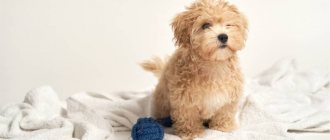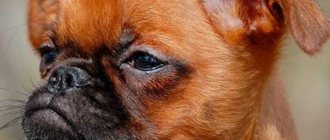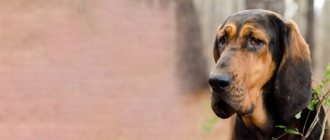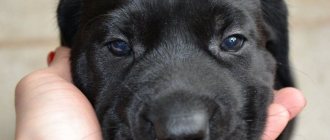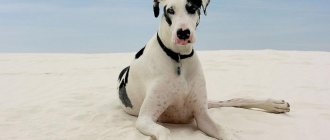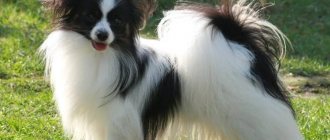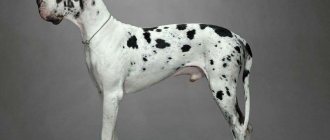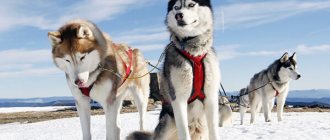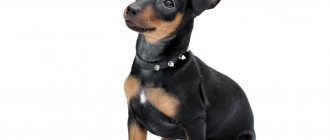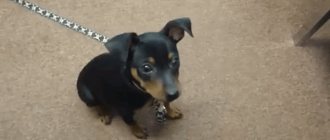Similar to plush toys, small dogs of the Bichon Frize breed are very popular: they are happily kept as companions, exhibitions are held for them, where the best representatives parade. The beloved Bichon Frize, whose photos adorn the albums, are full members of the family for all owners. These are amazingly kind and sweet dogs that respond with love to care for them.
Bichon Frize puppy photo
Little fluffy bichons are the most amazing animals among all lap dogs. They are friendly and at the same time unobtrusive. Puppies grow quickly and reach adulthood in less than a year. Unlike other breeds, the pet will not bother the owner with its barking and howling. Any rudeness on the part of the owner may offend the dog, but its forgiveness is very easy to earn.
Health, diseases of the breed
Bichons are healthy dogs with strong immune systems. They are considered long-lived among all breeds, and not only decorative ones. The lifespan of a Bichon Frize is 14-18 years.
The dogs do not have any special health problems, but the key to good health should be regular walks in the fresh air, close emotional contact with the owner and, of course, routine vaccinations and treatment for parasites.
However, this does not mean that Bichons are immune from congenital and acquired pathologies. Among the most commonly diagnosed diseases in the breed are:
- diabetes;
- epilepsy;
- urolithiasis disease;
- dysplasia of the hip and elbow joints;
- atlantoaxial instability (pathological condition of the spine);
- ophthalmological problems (corneal dystrophy, cataracts, entropion and eversion of the eyelids, etc.);
- dermatitis;
- hypotrichosis (hair loss);
- tartar.
Often, due to improper care and an unbalanced diet, Bichons develop allergies and obesity. That is why you need to monitor your dog’s nutrition from a very early age and avoid overfeeding. If an allergy is suspected, the veterinarian conducts special tests to identify the allergen and prescribes a mono-diet.
Bichon Frize photo of an adult dog
Adult lap dogs of other breeds show their superiority over their owner by barking at younger family members. A Bichon will never do this. Dog experts say that this little dog has a big loving heart, especially towards children. When the Bichon's patience runs out, he simply leaves and hides in a secluded place. Adult Frenchies are always white, although puppies can be cream or pale yellow.
What to name a dog
The choice of a name for a puppy directly depends on the imagination and attitude of the owner
When deciding on a nickname for your pet, you can use your own imagination, refer to the list of names of dogs that are stars or those belonging to famous people, but in any case, the choice must correspond to the appearance, character, and temperament of the Bichon Frize. In addition, the name should be easily perceived by the pet itself and be harmonious. Animal psychologists recommend choosing short nicknames for small dogs, consisting of one or two syllables.
Names for Bichon Frize boys
For perky, active, cheerful Bichon boys, for example, the following names are suitable:
- Archie;
- Barney;
- Bailey;
- Belchik;
- Bimbo;
- Mickey;
- Pixie;
- Snoopy;
- Stan;
- Fido.
Nicknames for girls
Charming, affectionate, playful pets of the Bichon Frize breed can be called as follows:
- Iris;
- Asta;
- Squirrel;
- Blanca;
- Waldi;
- Vita;
- Gina;
- Zhuzha;
- Button;
- Kerry;
- Katie;
- Lulu;
- Myra;
- Rina;
- Snowball;
- Sadie;
- Susie.
Bichon Frize breed description
The Curly-haired lapdog is a small and strong dog. Her cheerful temperament is revealed by her wagging tail and inquisitive eyes. The average animal is between 25 cm and 30 cm tall and weighs about 5 kg. Externally, the pet looks quite neat and elegant. The dorsal part of the narrow and somewhat elongated tail is constantly moving. It is always directed towards the back. The head part is proportional to the whole body. The skull is slightly rounded. The muzzle with small ears is completely covered with curly hairs. Legs are straight. The arched neck is long and the chest is well developed.
The fur is fluffy and silky, covering all parts of the body. Its length can reach up to 10 centimeters. The coat is predominantly white, complemented by finer shades of apricot and cream. Dogs can be either trimmed or remain with a natural coat, which is acceptable as a breed standard. The skin is dark, with blue, beige and black shades.
Key facts
Loyalty, affectionateness, playfulness, mischief - these are the characteristics of the Bichon Frize breed. Reviews from the owners of French lap dogs speak about one thing: these mischievous little balls of fur win the hearts of people and make people smile with their touching seriousness. Photos, pictures, videos cannot convey the charm of these dogs.
The Bichon Frize is a companion dog, a little mischievous, smart, completely silent, and has the indescribable charm of a walking cloud. Responds to sonorous calls. She loves children, active walks and everyone's attention to her person. Occasionally, a dog may express indignation with a menacing growl or a demonstrative refusal to eat. It is easy to train, but due to its character it can be undisciplined.
The dog practically does not shed, but the dense undercoat and white hair twisted into tight spirals requires careful grooming and daily combing. The description of the Bichon Frize breed explains that the dogs are hypoallergenic due to the absence of the characteristic dog odor and shedding.
Other names of the breed are used along with this one by the International Canine Association: French lapdog, curly-haired bichon.
The shortened name, "barbichon", comes from the merger of two French words "barbet" and "bichon". The dimensions of the Bichon Frize are miniature: weight in adult females and males ranges between 2.5 and 3 kg, height (height at the withers) is 25-30 cm. These values are typical for dogs in the “standard” category. Countries of origin: France and Belgium.
The lifespan of the Bichon Frize is long: they live approximately 12-15 years. The price for a dog starts from 30,000 rubles.
What does a French lapdog look like, what colors are characteristic of it? The Barbichon is a dog of a “dry” build, with an elongated muzzle tapering towards a black nose and playful black beady eyes. Often puppies are born cream colored and only become pure white by 12 months; No more than 10% of the cream “additive” is allowed in an adult.
Characteristics of Bichon Frize
Bichon Frizes are family favorites that love to play. They are joyful, affectionate and gentle. Small size and ease of care are the main reasons why dog breeders choose this breed for keeping in apartments. Excess agility and excess energy are removed by daily physical activity.
The advantage of the French lapdog is that its coat is hypoallergenic.
Bichons suffer from separation anxiety. They not only enjoy being with family, they need such an environment. Lapses are smart and love to learn different tricks. They get along well with other animals and people, but always warn their owner about the visit of strangers.
Puppy care
A Bichon Frize puppy moves to a new home at the age of 3-3.5 months. During this time, he manages to get used to the toilet and become independent. And owners have the opportunity to prepare for the arrival of their pet.
For a French lap dog, a dowry is purchased in advance, which includes:
- diapers;
- hygiene products;
- grooming tools;
- bed;
- carrying;
- toys;
- bowls;
- harness and leash.
Immediately after arrival, the Bichon puppy should be given time to familiarize itself with its new home and shown where the bowls, toilet and bed are located. And so that the baby does not miss his mother too much, a little thing with the smell of his native “nest”, taken in advance from the breeder, is placed on his bedding.
Important! At first, your French lap dog puppy may make puddles all over the house. Instead of scolding or hitting the baby, he is taken to a designated place and as soon as he relieves himself, he is rewarded with praise and treats.
As soon as the Bichon Frize puppy gets comfortable, they begin to teach him to be calm about hygiene procedures and adherence to the rules of behavior in the house.
So that you can go for walks with your French lapdog puppy without fear, he is vaccinated against:
- leptospirosis;
- rabies;
- parainfluenza;
- plague;
- corona and parvovirus enteritis.
The first vaccination for a Bichon Frize puppy is given at 8-9 weeks and repeated after 21 days. Before vaccination, the French lapdog is given anthelmintic drugs, the dosage of which depends on the weight of the pet.
Important! Some Bichons are sensitive to vaccines and do not tolerate them well. Therefore, the dog must be vaccinated by a qualified veterinarian familiar with the characteristics of the breed.
Bichon Frize character
A representative of the curly breed is considered an intelligent and lively pet. A cheerful attitude towards others is the main character trait of the Bichon. He loves to be the center of attention, so it's not surprising to see him perform tricks in the circus arena. The Bichon hates being alone and suffers greatly from separation. In such situations, they may chew and tear objects. The lap dog is not suitable for people who are away from home for long periods.
Heredity, training and socialization influence a pet's temperament. Puppies with a good character are curious and playful, and immediately run towards people. Males and females usually have the same temperament. The lapdog always monitors current events, so he will let you know when neighbors have returned or left, mail has been delivered, or guests have arrived. Like all dogs, the Bichon requires early socialization. They take it to busy parks, shops, or leisurely strolls along a crowded street.
Walking and exercise
Bichons are not athletes at all, but they can boast of good health and longevity. Throughout their lives, they are moderately active - they won’t get bored, but they don’t mind playing.
The foundation of their physical condition and proper development of the body is laid at the age of three to eight months. During this period, Frize puppies are playful and restless, as all babies should be, and their every day is full of new discoveries.
The already grown up Bichon plays a little less often, but still maintains a cheerful disposition under any circumstances. Even a small city apartment is quite suitable for your pet as an area for running, somersaulting and jumping. Playing and frolicking, this dog keeps itself in good shape. The owner should keep her company from time to time and remove all traumatic objects and wires from the floor.
You don't need to walk your Bichons every day. Although, of course, the dog will not refuse fresh air. When walking, the owner must remember that representatives of this miniature breed get tired easily and quickly. When ascending or descending stairs and other inclined surfaces, they must be carried by hand. Walking on asphalt should also be done in moderation, because their paws are very delicate, and their claws can be completely worn out in just a few hours. A soft, clean, short lawn is best for Bichons.
Bichon Frize pros and cons
When choosing a lap dog, it is advisable to carefully study its temperament and behavior in order to understand whether the animal suits the owner’s lifestyle or not. The appearance of the breed has nothing to do with compatibility. Positive traits:
- Adapts well to living conditions;
- Playfulness;
- Small size;
- Smart, easy to train pet;
- High life expectancy;
- Strong connection with the owner.
Cons of living with a Bichon:
- Hates loneliness and separation;
- High cost of maintenance, professional grooming;
- Increased pain: eye problems, allergic reactions, dry skin;
- Stubbornness.
How to choose a puppy
Mom with three Bichon Frize puppies
The main difficulty when choosing a Bichon Frize puppy is the lack of clear characteristics of the breed in young individuals. Often, under the guise of a French lap dog, you can buy an ordinary white fluffy dog that has nothing to do with this branch. If your goal is to acquire a standard show-class animal, not to mention representatives of the breed variety, it is worth involving an experienced specialist in this matter.
When meeting your future pet, immediately reject overly nervous, aggressive and cowardly individuals. It is unlikely that their character will improve with age. Otherwise, follow the same rules as when choosing any purebred animal. Get to know the living conditions of the dogs in the kennel, do not hesitate to ask the breeder to introduce you to the puppy’s parents, carefully study the veterinary passport of the future pet. But you shouldn’t pay attention to the Bichon’s weight and disproportionate head: during the process of growth, the animal very quickly gains muscle mass, and the shape of the skull gradually evens out.
The optimal age for Bichon Frize puppies for sale is 3-3.5 months.
Bichon Frize maintenance and care
Despite the increased activity of the dog, lap dogs feel good when living in apartments with proper care. The animal should not be left alone for long periods of time. To avoid having to deal with its destructive behavior, a wise owner will place a lonely dog in a fenced area. They begin to get used to hygiene in the first months of the puppy’s life. They treat the paws and look inside the mouth. The entire procedure is accompanied by praise and rewards, thus laying the foundation for easy hygienic care of an adult pet.
Your lapdog's teeth should be brushed two or three times a week to remove tartar and bacteria hiding inside. Don't worry if the first procedure is unsuccessful. To do this, choose the right toothbrush and dog paste. Pet products contain safe ingredients, but human paste contains toxic ingredients for dogs. You can brush your teeth with a special dog chew in the shape of a bone. Its action is similar to paste, but your pet will enjoy it.
Nails are trimmed once or twice a month, being careful not to cut them too short. Keep the ears dry and clean to prevent bacterial and fungal infections. Be sure to pay attention to the presence of sores, rashes, pain and inflammation on the skin, nose, mouth and legs. The eyes should remain clear, with no signs of redness.
Purpose
The breed, originally bred to hunt small rodents, is now entirely ornamental. Such pets do not have guard qualities and are not capable of showing aggression towards people, so animals should not be considered as guards and defenders.
Descendants of rat catchers, Bichons remain good human companions. The main purpose of a pet is to please and love the family of its owner.
What to feed Bichon Frize dogs
The average weight of a lap dog is 5 kg. Based on this, inactive and older animals should receive 300-500 calories per day, but active Bichons should receive 404-660 calories. Puppies should be fed more frequently and in a balanced manner during the first year of life. There are products labeled for different stages of a dog's life: puppy and adult. They contain the correct ingredients and calories for the designated steps.
It is recommended to divide the daily diet of an adult Bichon into two portions and feed it in the morning and evening. Puppies have three meals a day. This will allow your lapdog to eat small meals and also control her appetite. Canned and dry food is essential for the health of dogs. Its crunchy texture will help scrape plaque off your pet's teeth. Canned food does not provide the same cleansing benefits, but does contain water. Its quantity is important for the Bichon, because the dog is susceptible to developing urolithiasis.
Canned food and dry food can be mixed. When combining products, be sure to calculate their total calorie content. The lap dog's diet should include protein found in poultry, fish and beef. Whole grains such as barley, buckwheat, oats and brown rice will provide your dog with fiber and carbohydrates. They are easily digestible. Products containing vegetable and fish oils will be natural sources of fats and omega-3 fatty acids. They will help maintain thick fur, and also give it shine and softness.
You should not feed your pet beet pulp, tomato pulp or products with artificial colors. Sausage, pickles, cookies, sweets, beans and semolina are contraindicated for them.
Feeding
The correctness of the diet for the Bichon Frize can be determined by the healthy fatness and well-developed muscles of the dog. This breed follows moderation in its diet, and when it has eaten, it can leave behind excess food. If there was not enough food, the dog licks the empty bowl.
When feeding your pet, follow some rules:
- Food consumption occurs in an adult dog in the morning and evening;
- The dog should always have fresh water to drink, especially when feeding dry food;
- If your diet is based on natural products, then preference should be given to raw rather than cooked food. The cereals are soaked, and the meat and sea fish are doused with boiling water. Only river fish is subject to heat treatment;
- The feed should be moderately crushed;
- Salads made from raw vegetables should be seasoned with a small amount of sour cream or vegetable oil;
- The daily diet should include nutritional supplements containing glycerophosphate, calcium, phytin, bone meal and vitamins.
Training a Bichon Frize
The dog is quite smart, but with age it can show its stubbornness. Training begins from the first days of life. At eight weeks the puppy is able to follow simple commands. You can entrust the upbringing to a specialist or start home schooling and socialization with family and friends. The first commands that a puppy should learn:
- Sit;
- Quiet;
- Stand;
- Lie;
- Ugh;
- Bed.
Lapses love to perform tricks and learn new things. They respond well to training based on positive reinforcement rather than harsh or negative methods. The Bichon Frize is known to be a resourceful little dog that is always eager to please.
Prices for dogs
Nowadays, the Bichon Frize is a common breed, so there will be no problems with buying a dog. To purchase a puppy, it is better to contact nurseries or experienced breeders and be sure to ask for a veterinary passport. So how much do puppies of this breed cost?
Bichons are known as the dogs of aristocrats. The price of the puppies corresponds to this. The cost of dogs varies depending on the pedigree, region of purchase, age and class of the puppy. Babies without a pedigree cost from 10 to 20 thousand rubles.
A purebred puppy with a good pedigree in Russia costs around 30-40 thousand rubles, a puppy from champion parents is much more expensive - up to 85 thousand rubles.
Bichon Frize are beautiful, funny dogs that are devoted to their owner. These are little therapists who treat the owner’s physical and mental wounds. If you are looking for a friend, take a closer look at dogs of this breed. They will give you tender feelings and a lot of positivity.
Bichon Frize Haircuts
The lap dog's hair is long and curly, so it requires an artistic haircut by a professional groomer or an experienced owner. An unkempt coat becomes dull, mats, and can cause serious skin infections. The outer layer of hair develops after a year of the animal's life. Before this, there is no need for daily cleaning, but if this is not done, it is impossible to achieve obedience from an adult pet. In addition to daily combing, be sure to cut off the area on the back of the nose near the eyes, capturing the transition between the forehead and muzzle (no more than 0.5 cm).
For males, the areas near the genitals are cleaned once a month, and a strip of 1 cm in size is also made at the base of the tail. For this, it is recommended to have special scissors. To facilitate this procedure, some owners purchase special stands with a strap. The entire process usually takes at least an hour.
Abilities and skills
Frizes are distinguished by their mobility, high intelligence and learning ability. Animals do not show aggression towards children and are patient with their pranks. A companion pet does not tolerate loneliness well, but the Bichon will not interfere with the owner’s rest after work, but will simply settle down next to him on the bed.
Dwarf dogs become frequent guests of circus performances, where they demonstrate the ability to carry out a variety of commands from the trainer.
Bichon Frize nicknames:
I would like to name the miniature and funny pet accordingly. Here are the most suitable and popular nicknames for boys and girls.
girls
Girls are often called:
- Lilly
- Mia
- Gracie
- Stella
- Moon
- Sophie
- Lola
- Molly
- Bella
- Snowball
- Front sight
boys
Male nicknames sound good:
- Fluff
- Snowball
- Tisha
- Charlie
- Toby
- Duke
- Oliver
- Jake
- Teddy
- Leo
- Louis
- Zeus
Character and appearance
Due to the peculiarity of their coat, the structure of the skull bones and their miniature size, Bichons are sometimes called “snow-white dandelions” or “fluffy clouds”. The pet's character corresponds to its affectionate nicknames: representatives of the breed are easy-going, playful and friendly, get along with children, and quickly get used to other pets and strangers.
Companion dogs love active games and running, but long walks tire Bichons. Pets do not tolerate loneliness well, so leaving such an individual unattended for a long time is undesirable. If the owner is absent for a long time, dogs lose their appetite, become sad, howl, and can do minor mischief in the house (gnaw shoes, throw things around, etc.). The Bichon Frize is not prone to feeling guilty.
The breed behaves similarly if it does not receive proper attention and lives in an atmosphere of indifference.
But if you organize a small play area for your pet at home, the Bichon will be able to entertain itself.
Expert opinion
Anna Abramenko
An avid dog lover. Experience in veterinary medicine since 2009.
Ask a Question
The presence of large (dewclaw) toes on an animal's limbs is not welcome; usually such rudiments are removed from the pet.
How to wash a Bichon Frize?
Bathing a lapdog is similar to other breeds, but has several important differences:
- A rubber mat will help keep your dog from slipping in the bathtub or sink.
- Each time you bathe, cotton balls are inserted into your pet's ears. This will protect the canals from moisture and painful ear infections. They are removed immediately after the procedure.
- A shower hose is required for swimming. Maneuverability and water pressure will allow the dense texture of the wool to be completely saturated with moisture, which is difficult to achieve when pouring from a cup or using a sponge.
- The type of shampoo is individual. Bichons have dry, sensitive skin, which makes exposure to chemicals worse. For bathing, choose a product without any dyes or fragrances.
- In addition to dry skin, a dog's dense, bristly hair is also prone to dryness and matting. A moisturizing conditioner left on the coat for three to five minutes and then rinsed well will help detangle the curls after drying.
- A thorough wash is carried out once a month, although hygiene of the legs, face and genital area is carried out daily. Experts recommend using diluted shampoo for bathing.
Upbringing
First of all, they need to be accustomed to the toilet, the area where they will eat, and the rest area. Monitor your puppy’s attempts to chew furniture and stop it. Gradually teach the necessary commands, the simplest and most common ones. It is best to do this through games and learn only one at a time, so the dogs will better assimilate commands and be more willing to carry them out. Don’t forget to reward the animal after the command has been learned.
Watch the intonation, give commands in a stern voice, but you need to praise in a more emotional tone, then she will be able to quickly understand what they want from her. Try to scold as little as possible, only when absolutely necessary, but at the same time do without shouting. You must become a friend to your pet so that he is not afraid of you.
Clothes for Bichon Frize photo
Bichons look very cute in a dress or sweater, but do not forget about the convenience of such outfits for the animal. There is no right or wrong answer—clothing is beneficial or harmful.
The main thing in this matter is to make sure it is safe. For example, a scarf may wrap too tightly and accessories may cause choking if swallowed.
- To protect the Bichon's feet from the cold and salt on icy sidewalks, owners wear special booties. These shoes are ideal for hot sand, asphalt, hiking, rain and snow.
- Dog dresses can be casual or stylish for special occasions. They have matching floral leashes sewn into the D-ring. Neck and chest clasps make it heavy-duty and secure for easy on and off.
- Denim dress for a dog.
- Cotton breathable T-shirt.
- A Bichon can become Santa Claus's little helper at Christmas.
- The animal is protected from bad weather by an adjustable raincoat or jacket.
- For training and walking, the pet is dressed in a casual tracksuit.
- If a dog enjoys wearing a hat to entertain its owner, then why not wear this protective headgear.
Education
Bichons are relatively easy to train. The main thing that the owner should emphasize is the traditional obedience course for dogs of all breeds. These creatures do not need special training.
Curly-haired lap dogs require gentle, careful, and consistent (the step-by-step method always works) parenting and training methods. A delicate character, an unexpectedly strong spirit for such a miniature dog and a desire for independence can become a difficulty for the owner, but everything is solved by simple (but sincere; dogs simply “read” hypocrisy) faith in the abilities of the beloved pet and attentiveness. First, you need to learn the classic commands: “Come to me!”, “You can’t!”, “Place!”. This will require the perseverance and determination of the teacher, but under no circumstances should you resort to aggression and shouting. Bichons perfectly understand your commands, but do not always want to carry them out - before success and the subsequent joy of the owner, the pets need an enchanting prelude of disobedience.
The Bichon is a decorative dog. It goes without saying - most modern people get them not only because of their beauty, but also because of their small size and undemanding nature in terms of care and walking. Therefore, over the years, curly-haired lap dogs have learned to relieve themselves in the litter box, since daily walks are rare for them (and not always necessary). If you decide that you will only walk your dog occasionally, train him to use a litter tray from early childhood, just like a kitten.
Bichon Frize reviews
Lucky became a real consolation for our son when our cat died. He loves chasing animals and swimming in the park pond. He enjoys playing children's games and follows his son like a magnet. Everyone wants to pet him and hug him. If an animal sees someone approaching it, it immediately lies down on its back to be scratched. Irina, Voronezh
The possession and patience of the French lap dog is enviable. She is cheerful and playful. Has a strong will, but strives to please the owner. Lilly loves the sea and the beach, and sometimes goes fishing with us (with a life jacket). I do my haircut myself, although it takes a lot of time. In winter, I dress the dog in a jacket to keep his body warm. Marina, Krasnodar
I am absolutely crazy about the Bichon and recommend him to all my friends. A wonderful animal that makes you smile once again. Brian regularly meets me at the door, and hears my steps even on the stairs. Kristina, Vladivostok
For those looking for a small, cheerful dog that will get along with other animals and children, you can't do better than the French lapdog.
Brief history of origin
Experts have still not been able to figure out how the Bichons appeared. Presumably, they descended from Barbets, and the name of the breed is derived from “Barbichon”.
According to one version, Bichons were bred in Italy and, together with merchants, came to Tenerife along the Phoenician trade route. And from there, in the 14th century, dogs were brought to France. Another theory is that bichons were brought to Tenerife by Spanish sailors. And in the 14th century, the Italians returned them to the mainland.
In Europe, the Bichon Frize dog quickly became a favorite of the local nobility. She lived at the court of the French king Francis I and the English monarch Henry III. The latter was so attached to his dogs that he carried them everywhere with him in a basket hanging around his neck.
Gradually, interest in the breed began to fade. By the second half of the 1800s, the Bichon Frize began to be seen as ordinary dogs, sometimes kept by circus performers and street musicians.
The official name “Bichon Frize” was assigned to it in 1933. At the same time, the International Canine Association developed a general description of the breed. After the end of World War II, French breeders again became interested in the breed and began working to preserve it. Bichons came to the United States only in the 1950s. And British breeders learned about them in the mid-1970s.
Human Compatibility
The Bichon Frize is less likely to give you allergies than other dogs. With proper maintenance (frequent combing of wool and wet cleaning of the apartment), it is also suitable for allergy sufferers.
He is happy with his owners and guests, is friends with children, and does not get into fights.
The Bichon Frize is less likely to cause you allergies.
What should you pay attention to when choosing a puppy?
The breeder should be extremely interested in you as a new owner, give detailed instructions, ask questions about the conditions and experience of caring for the dog. If the dog breeder answers briefly or finds it difficult to answer some question about maintenance, try not to contact him.
Breeders do not sell puppies under 3 months of age
- Inspect the room in which the dogs live, it should be clean, bright and fresh, the dogs should be active and happy.
- Study the appearance of the bitch and the stud dog. Check the mating certificate, pedigree, veterinary passport, brand.
- If parents have titles, ask for confirmation: awards, certificates and diplomas.
- Then look at the puppy card issued by the Russian Canine Federation. It will give you the opportunity to participate in all RKF exhibitions.
- The last vaccination in the veterinary passport should be no more than a week ago, and the brand must match the brand on the puppy itself.
- Make sure that the breeder has sufficient rights to sell the puppy, and that the acts of sale and acceptance are completed correctly.
- After checking the documents, talk to other pets, observe them, evaluate their behavior: they should not be lethargic, fearful, hyperactive, too loud or aggressive.
The Bichon Frize will make a great friend and companion.
- Be sure to ask the breeder questions about the dog’s character, hereditary diseases, features and exterior flaws.
- If you want to participate in shows or breed Bichons, but do not have enough experience, do not hesitate to invite an independent expert who will determine compliance with the breed standard to avoid deception.
- The breeder must give you the most detailed recommendations on feeding, care, transportation (certificate F1), and preparation for exhibitions.
Example of F1 form certificate
